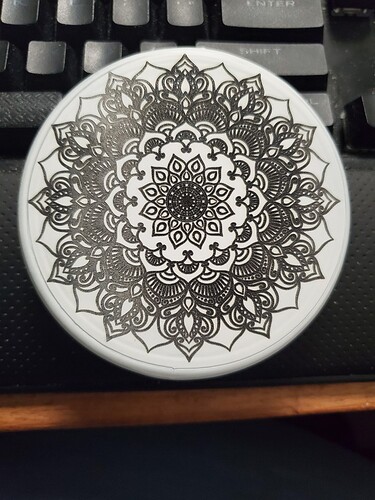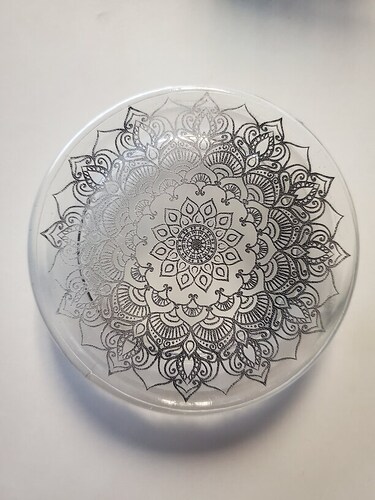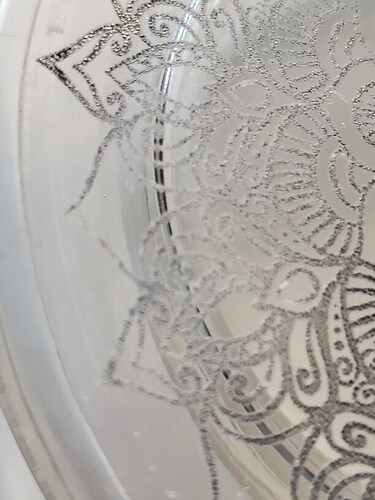I’m using rustoleum 2x flat white.
Oh, I have that in the garage!
I think I am using the same stuff. I want to get it without the primer, thats mainly why i want to try that chalked paint.
Interesting, I tried to research the glass tiles (Jeffery Court) and it says that the backs are painted. I can’t find out with what, but I would be curious to find out what ingredients the have in common.
Those are really nice. Means we don’t have to mess around trying to get Laser Tiles anymore  They were expensive & very erratic in shipping.
They were expensive & very erratic in shipping.
Wonder about other paint colors. That would be neat. I’m thinking maybe it’s the titanium dioxide in white though.
Guys, this is great! I love a good treasure hunt. 
Once the risk of thunderstorms has left my area I am going to try and see if i can get score lines to turn black. Maybe a really defocused pass with high power? could be interesting
I tried it on steel just to see… HEY! DON’T JUDGE ME!!! ![]() That was a no-go and I figured it would be. It darkened but didn’t stick.
That was a no-go and I figured it would be. It darkened but didn’t stick.
Then I did it on the only glass I could find. Mixed results. It definitely works. But I had some that was sort of faded and some that worked pretty good. I did NOT clean the glass first and that could well be the problem. So test glass yourself.
It DOES seem far more raised than it does on the ceramic tile though so something definitely different about it. But still just as permanent I think.
with the white paint still on it
You can see the left side (which I think was probably on the horizontal plane and not the vertical in the machine. I forgot to mark which it was before I pulled it out) where it’s almost whitish instead of dark.
And a couple closeups.
340lpi / 25 power / 225 speed
What! The hatched circle in a square looks 3D 
Its making me dizzy.
Thx hehe, was one of my favorite optical illusions so I made it in inkscape for fun. In sunlight in person it makes you pretty dizzy as well lol
Awesome  , thx for testing it on glass. I’ve been itching do that. I’m not sure how important it is but i have been cleaning all my tiles with alcohol before I paint.
, thx for testing it on glass. I’ve been itching do that. I’m not sure how important it is but i have been cleaning all my tiles with alcohol before I paint.
I cleaned my tiles as well. I should have done so with the glass too but I was being lazy.
Very excited about all these experiments, fellas. You’re getting some exciting results. I can’t wait to give it a try!
Excited to see what you come up with 
There will be a lot of titanium in the glaze I expect as well.
Was thinking about colors, and speed and just as a wild hare mixed a bit of turmeric with some white glue and too much water and started to run it at 140 zooms and 2 pews and 640 LPI but thought that 7 hours would be a long cut so cut it back to 340 LPI and to go with 3.5 hours instead for a first run.
After 2 hours I bailed halfway as the inconsistency of the paint was having a greater effect than the design but it did work. On reflection as in reflecting in the glaze, the design shows as not as shiny in the areas supposed to be dark and shiny where it is supposed to be lite with much more discrimination than the thickness darkened or did not darken the color.
a few things noted…
-
check out the shininess of the glaze. Even if you are not getting the large divots of regular lasering of tile, I strongly suspect that you are getting really tiny ones, filled with carbon as you burn the paint, so not so different as regular, but cut and paint at the same time,
-
2 pews actually work and do “damage” the tile surface so 20 pews may be overkill.
-
Even 2 pews turns turmeric to carbon, Something I would not be certain of without testing.

Interesting. I know in the case of the glass candle lid I did, it was not pitting the glass. It is actually raised significantly. On the tile it doesn’t feel divoted but neither does it feel as raised. I tend to lean in your direction that it’s probably etching the tile and filling it at the same time, but whatever else is going on it is incredibly durable as well. Not sure what’s going on with the glass though.
i wonder if what’s happening is at the low power/high speed combo, you’re melting or fusing some of the surface glaze enough to burn the paint into it, but without enough power to cut through the glaze and into the tile itself.
At this point anything is possible. My current guess is sorcery. Though your guess would also explain why paint darkened but did not stick on the steel test. But… sorcery.
I am currently doing one layer of paint and upped the power to 8 as 2 was not disturbing the paint. The design is very dependant on grayscale and I am getting great discrimination but too light. I think if I move away from the bottom level of dot dither it will improve a lot.
I still think you are getting carbon in fine cracks. If you were affecting the glaze it would be a puddle instead of spall crazy at high power.





